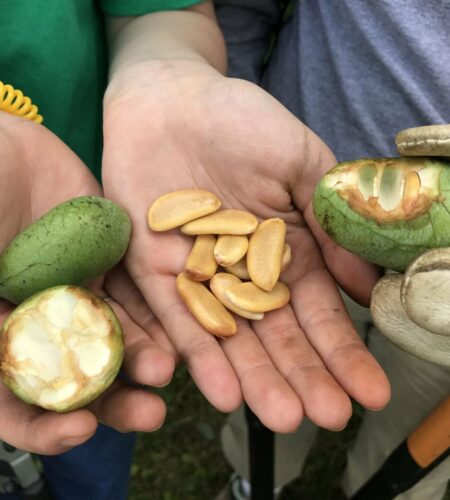As summer gives way to autumn’s crisp breezes, North America’s once-forgotten fruit, the pawpaw, is experiencing a remarkable revival. This native fruit, which has been largely overlooked for decades, is now garnering renewed interest and appreciation. Known as the largest edible fruit native to North America, the pawpaw’s resurgence is driven by a growing awareness of its unique flavor and nutritional benefits. From local festivals to dedicated culinary efforts, the pawpaw is slowly emerging from obscurity, reconnecting with its historical roots and finding a place in modern kitchens.
A Taste of History
The pawpaw, with its custard-like texture and flavor profile blending banana, mango, and vanilla, has deep historical roots. Native Americans were among the first to enjoy this fruit, incorporating it into their diets long before European settlers arrived. Historical accounts from figures like Hernando de Soto, Lewis and Clark, and even George Washington highlight the pawpaw’s role in early American cuisine. Washington’s diary mentions planting pawpaw trees at his estate, and there’s even a story that chilled pawpaw was his favorite dessert.
The Pawpaw: An Underappreciated Gem

The pawpaw is an intriguing fruit with a complex flavor that can be described as a blend of tropical and floral notes, reminiscent of mango, banana, pear, and hints of vanilla and caramel. It grows on a small, understory deciduous tree native to the eastern United States. Its oblong shape and custard-like texture make it a unique culinary delight, though its short shelf life and delicate nature have limited its widespread commercial appeal.
Historically, the pawpaw was a staple for Indigenous peoples and early settlers, often enjoyed in its wild form. Despite its rich past, the pawpaw fell into obscurity, relegated to niche markets and local consumption. Modern cultivation efforts focus on improving fruit varieties to extend shelf life, reduce seed size, and enhance flavor. These efforts have sparked a resurgence of interest in the fruit, as chefs and food enthusiasts seek to rediscover and celebrate its unique qualities.
Pawpaws offer nutritional benefits as well. They are rich in potassium, vitamin C, and several essential amino acids, making them a healthy addition to any diet. However, due to their limited availability and short season, finding fresh pawpaws can be a challenge, often requiring visits to farmers’ markets or specialty retailers.
The Ohio Pawpaw Festival: A Culinary Extravaganza

Southeast Ohio, known for its lush forests and rolling foothills, hosts the Ohio Pawpaw Festival each year at Lake Snowden, just outside Athens. Although this area has an abundance of pawpaws, the fruit has yet to become a mainstream commodity. Instead, it thrives in the local culinary and cultural scene. The festival, with its theme “Pawpaws to the People!” celebrates the fruit’s rich heritage and diverse uses.
What began as a small gathering of around 100 attendees has grown into a major event attracting approximately 10,000 visitors from across the country and beyond. Highlights include musical performances, a pawpaw cook-off, eating contests, and various creative competitions. Attendees can enjoy pawpaw-themed foods such as mousse, cotton candy, curry, and ice cream, as well as locally crafted pawpaw beers and kombucha.
Chris Chmiel, the festival’s founder, has been instrumental in promoting the pawpaw. His farm, Integration Acres, is the largest pawpaw processor in the US and supplies fresh fruit and pawpaw products to festival-goers. The festival atmosphere is further enriched by themed merchandise, artwork, and even a pawpaw mascot, making it a festive and immersive experience.
Challenges and Opportunities
Despite its potential, the pawpaw faces significant hurdles. Its short shelf life and specific growing requirements—such as low, wet conditions—have kept it from becoming a commercial staple. As a result, the pawpaw remains a niche product, primarily available at farmers’ markets or through direct-to-consumer sales online.
However, the tide is turning. Scientists and researchers are exploring ways to extend the pawpaw’s shelf life and enhance its market appeal. For example, Iowa State University is developing pawpaw varieties with longer shelf lives and fewer seeds, while Kentucky State University is researching the fruit’s ecological benefits and potential as a sustainable crop.
Looking Forward
As the pawpaw gains visibility, its future looks promising. The dedication of festival organizers, researchers, and culinary enthusiasts is helping to revive interest in this once-forgotten fruit. While it may still be a rare find in grocery stores, the pawpaw’s growing popularity is a testament to the power of community and innovation in preserving and celebrating our food heritage.
For those eager to taste this remarkable fruit, local farmers’ markets and online retailers are the best places to find fresh or frozen pawpaw products. As awareness continues to spread, the pawpaw may soon find its way into more kitchens, offering a delicious connection to North America’s culinary past.


